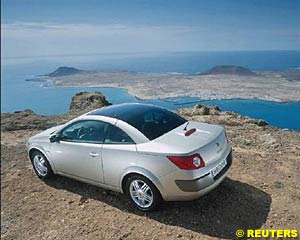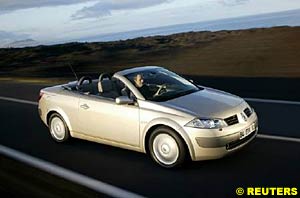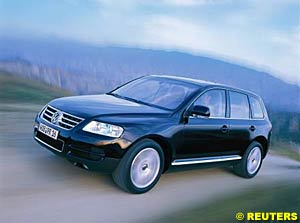

Automotive News and Reviews for the Petrolhead
Reuters Motoring Commentator
In this week's issue:
- Hitting the Glass Ceiling
- Touareg Touts Tidal Wave of Torque
A hard-top convertible used to be a rarity. First came the Mercedes SLK with its revolutionary folding metal roof. Then Lexus, Peugeot and Daihatsu followed suit. And now, we have two mid-sized mainstream "coupe convertibles" arriving at once - Peugeot's 307CC and Renault's Megane Coupe-Cabriolet.
Booted and Suited
The glass roof isn't just a clever bit of design, it does much to set the Megane apart. More importantly, given Renault's sales message that you can have ?two cars for the price of one', it gives the car a rather classy as well as glassy air of Gallic diffidence in Coupe form. Few convertibles look better with the roof up. Given that we have in all probability already used up the next decade's quota of sunshine this year, the Coupe-Cabriolet needs to be both attractive and refined with roof up. Mission accomplished.
If you need to get the roof down quickly when a few minutes of sunshine beckon, there are no latches to undo. A single press of a button will fold the two glass panels and arrange them neatly in the boot in 22 seconds. It couldn't be any easier. Wind buffeting is kept to a minimum when the optional wind deflector is fitted, but the wind does insist on picking up and flapping the top of the seatbelt about.
Even with the roof down, the boot retains an impressive amount of space for a convertible. But you'll have to keep the roof up or use the back seats if you're planning a few overnight stays. In Coupe form there is a very generous 490 litres of boot space, as practical as a saloon of comparable size.
Renault has made a decent stab at making the Coupe-Cabriolet distinctive and elegant. Of course, big boot space does mean an over-sized behind, but the glass roof works well visually and a lot of work has been done on the side panelling to make the car look sleeker. Only the front grille, headlamps and bonnet are taken from the hatch.
Insise Edge
The cabin is a familiar sight to anyone who has driven the Megane hatch. The dashboard and the front seats are identical but the seats are mounted 24mm lower. This increases headroom and reduces the claustrophobia inherent in many convertibles. The quality of the cabin materials, including soft-touch plastics, is also a big improvement Renault's previous generation Megane convertible.
Any maker of a four-seater is genetically programmed to claim there is plenty of room for four adults. Journalists are genetically programmed to be sceptical. The Renault is comparatively generous in the back but when there's only 8.5cm of knee room, persuading two adults in the back for more than a few minutes would require remarkable diplomatic skills as well as an over-sized shoe horn. But the front seats are far better, with seat height and steering wheel adjustment making it easy to find a comfortable seating position.
The Coupe-Cabriolet should never be mistaken for a sports car. The hatch isn't the sportiest of models in any case. The extra weight of the glass roof and the body stiffening needed to improve rigidity make the car a little lardy. On the plus side, crash protection is excellent and the work on rigidity has worked pretty well - the Coupe-Cabriolet cabin suffers few vibrations.
Even so, more powerful engines are needed to complete the range. The steering doesn't help either, leaving you feeling rather alienated from the car. But the ride quality is smooth, even if fast bumps cause a certain amount of wallowing.
Renault is now firmly established as the most safety-conscious car manufacturer, so occupant protection is well attended to. There are six airbags fitted as standard as is ABS and Brake Assist. A rarity is that automatic pop-up roll-over bars can be specified as an option, showing themselves only when an imminent roll-over is detected.
Otherwise, equipment levels are unexceptional, although automatic headlights and rain-sensor wipers are fitted. On the flip side it is attractively priced. The Megane Coupe-Cabriolet is no sports car, but its solid looks make it as natural a home for a man as for a woman - a rarity. Furthermore, it does look good. It's a highly successful attempt at an open-top hatch, one of the best yet, just don't expect any thrills. It goes on sale in November.
Written by Ian Summer
Fourteen buttons and one thumbwheel. That's how many controls I counted on the steering wheel of Volkswagen's new Touareg. And that's all you need to know about just how complex VW's giant new 4x4 is.
VW is not used to doing things by halves. It has a plan for world domination and that includes everything from the cheapest new car on the market (with the forthcoming Lupo replacement, the £5000 Fox) right up to a Mercedes-baiting executive saloon in the shape of the Phaeton. Part of that grand plan is to offer a world-beating 4x4.
VW's first-ever off-road vehicle is probably the most technically sophisticated 4x4 vehicle on the road. To that end it gets the world's most powerful diesel engine, an all-aluminium 313bhp V10. It simply pulverises the opposition in terms of torque output. It is a genuine tidal wave, peaking at a scarcely believable 553lb ft. Compare that to the Range Rover Td6, which has a mere 288lb ft and you see the gains VW has made.
Off-Road GTI
You immediately feel the impact when you plant your right foot to the floor. Progress is relentless from rest right up to the higher echelons of autobahn storming speed. VW's official 0-62mph time of 7.8 seconds feels conservative - I'd put it at closer to seven seconds dead. That makes the Touareg the world's first two-and-a-half tonne off-road diesel GTI.
4x4 are not really 0-60 times though. They are about lugging ability and the Touareg is an arch-lugger, with most of its torque available from below 2000rpm. It just chugs away in high gears without a need to change down. The six-speed automatic gearbox is as smooth as an executive saloon's. In terms of refinement, it is truly extraordinary: there is only a muted gruffle from the V10 engine.
Serious Off-Road Skills
The Touareg boasts serious off-road skills, as I discovered on a demanding mud-plug. It has the grown-up 4x4 facilities of a low ratio transfer box and a very impressive hill start control. Vast phalanxes of electronic relays keep the wheels gripping. However the independent suspension and monocoque construction don't have the articulation of a separate-chassis 4x4 and I did spot a wheel occasionally lifting on the serious stuff. On the other hand, VW claims that not only will its Touareg ford water up to a depth of 580mm but will even float, apparently.
Inside, a beautifully finished cabin is very spacious. There is plenty of room for five full-size adults, and its 1570-litre boot compares well with its main rival, the BMW X5. The upper tailgate lifts up separately to ease access in tight parking spots.
Plenty of Kit
As for kit, you get what you'd expect for £50,000, including xenon lights, keyless ignition, parking sensors front and rear and a monster hi-fi system. You can even programme footwell illumination intensity.
I could go on forever about exactly what the fourteen buttons on the steering wheel do - for example, there's a little button to turn the illumination on the steering wheel off to make fast steering turns less confusing at night. But I won't bore you. Take it from me, the Touareg is stuffed with, well, stuff.
VW deserves a pat on the back for doing such a credible job with its first-ever off-roader. Most buyers will opt for the 2.5 TDI version which kicks the Touareg range off at £28,600. The 3.2 V6 weighs in at £29,340 - smack bang in BMW X5 and Volvo XC90 territory - with the V8 at £41,800 and the mighty V10 diesel tested here at £50,445.
So does the Touareg have it all? It gets surprisingly close except for one thing: its badge. While VW is the undisputed badge king in the Golf sector, at this level it's got to compete with BMW, Volvo and Range Rover. It remains the poor cousin until, that is, VW achieves world domination. I'd give that eventuality about a 50/50 chance of succeeding.
Written by Chris Rees
![]() Hitting the Glass Ceiling
Hitting the Glass Ceiling
 Peugeot and Renault have indulged in a little friendly banter over who offers the widest engine choice (Renault) and who sells the most powerful engine (Peugeot). But a big difference between the two comes from Renault's efforts to break away from the rising tide of folding metal and become the first hatchback-based convertible to offer a folding roof made of glass.
Peugeot and Renault have indulged in a little friendly banter over who offers the widest engine choice (Renault) and who sells the most powerful engine (Peugeot). But a big difference between the two comes from Renault's efforts to break away from the rising tide of folding metal and become the first hatchback-based convertible to offer a folding roof made of glass.
 The car driven here was powered by a 1.9 dCi diesel - something of a rarity for a convertible - driven through a six-speed manual gearbox. It's less powerful than the 2-litre petrol but makes up for it by having more torque available. This suits the character of the car better as the Coupe-Cabriolet is not a performance car.
The car driven here was powered by a 1.9 dCi diesel - something of a rarity for a convertible - driven through a six-speed manual gearbox. It's less powerful than the 2-litre petrol but makes up for it by having more torque available. This suits the character of the car better as the Coupe-Cabriolet is not a performance car.
![]() Touareg Touts Tidal Wave of Torque
Touareg Touts Tidal Wave of Torque
 But what's it like on-road? This is where it comes unstuck just a little, for its rivals like the BMW X5 and Volvo XC90 have it licked. At low speeds, ride quality is unsettled and, while its handling is surprisingly good for such a bulky machine, it doesn't match the crispness of an X5 or the comfort of an XC90.
But what's it like on-road? This is where it comes unstuck just a little, for its rivals like the BMW X5 and Volvo XC90 have it licked. At low speeds, ride quality is unsettled and, while its handling is surprisingly good for such a bulky machine, it doesn't match the crispness of an X5 or the comfort of an XC90.
© 1995-2005 Kaizar.Com, Inc. . This service is provided under the Atlas F1 terms and conditions.
|
Volume 9, Issue 42
Atlas F1 Exclusive
A Touch of Greatness
Interview with Kimi Raikkonen
Interview with Jock Clear
Ann Bradshaw: View from the Paddock
2003 Japanese GP Review
2003 Japanese GP Review
The Boardroom View
The Pressure Game
Stats Center
SuperStats
Charts Center
Columns
Season Strokes
On the Road
Elsewhere in Racing
The Weekly Grapevine
> Homepage |